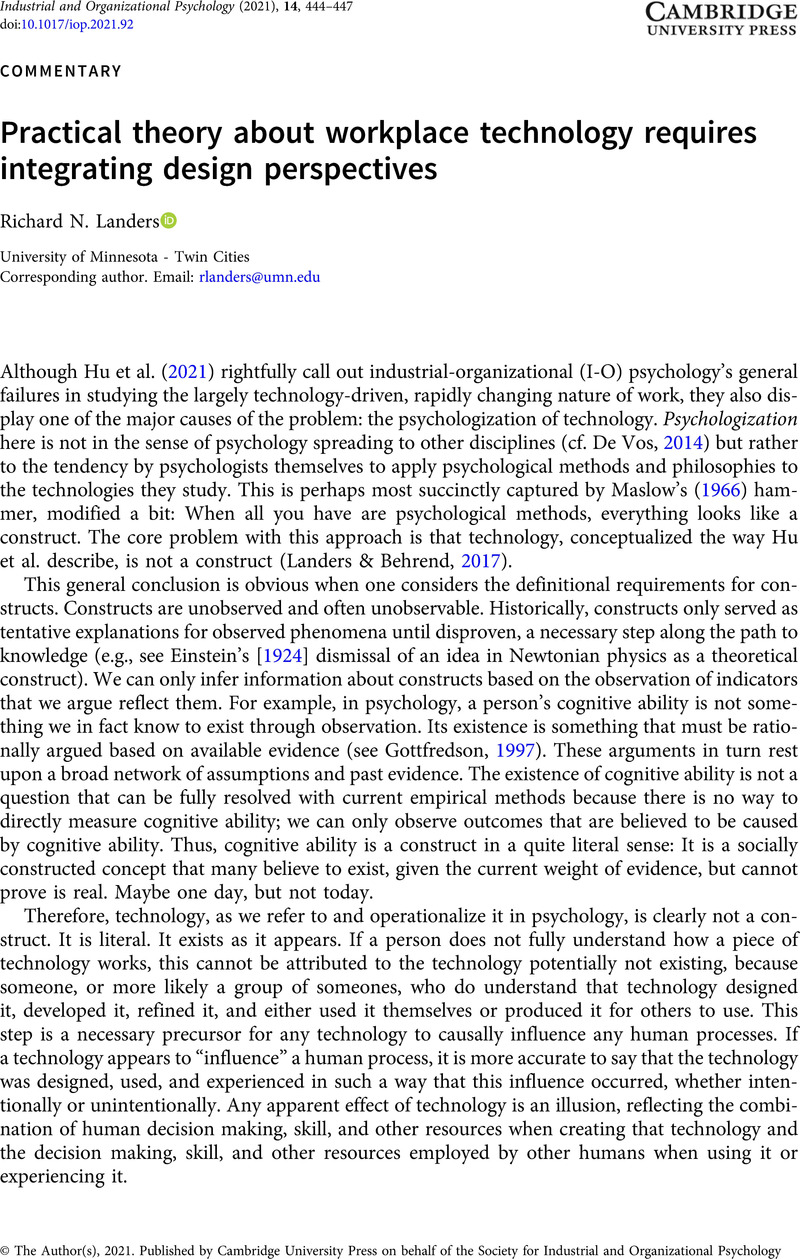No CrossRef data available.
Article contents
Practical theory about workplace technology requires integrating design perspectives
Published online by Cambridge University Press: 22 September 2021
Abstract
An abstract is not available for this content so a preview has been provided. Please use the Get access link above for information on how to access this content.

- Type
- Commentaries
- Information
- Copyright
- © The Author(s), 2021. Published by Cambridge University Press on behalf of the Society for Industrial and Organizational Psychology
References
Arthur, W. Jr, Keiser, N. L., & Doverspike, D. (2018). An information-processing-based conceptual framework of the effects of unproctored internet-based testing devices on scores on employment-related assessments and tests. Human Performance, 31(1), 1–32.CrossRefGoogle Scholar
Arthur, W. Jr, Keiser, N. L., Hagen, E., & Traylor, Z. (2018). Unproctored internet-based device-type effects on test scores: The role of working memory. Intelligence, 67, 67–75.CrossRefGoogle Scholar
Carter, V. (1996). Do media influence learning? Revisiting the debate in the context of distance education. Open Learning: The Journal of Open, Distance and e-Learning, 11(1), 31–40. https://doi.org/10.1080/0268051960110104
CrossRefGoogle Scholar
De Vos, J. (2014). Psychologization. In Teo, T. (Ed.), Encyclopedia of critical psychology (pp. 1547–1551). Springer. https://doi.org/10.1007/978-1-4614-5583-7_247
CrossRefGoogle Scholar
Einstein, A. (1924). Über den Äther (Trans.). Verhandlungen Der Schweizerischen Naturforschenden Gesellschaft, 105, 85–93. Retrieved from http://www.jonathonfreeman.org/wp-content/uploads/2018/05/Einstein-Concerning-the-aether-1924.pdf
Google Scholar
Gottfredson, L. S. (1997). Mainstream science on intelligence. Intelligence, 24(1), 13–23.CrossRefGoogle Scholar
Hu, X., Barber, L., Park, Y., & Day, A. (2021). Defrag and reboot? Consolidating information and communication technology research in I-O psychology. Industrial and Organizational Psychology: Perspectives on Science and Practice, 14(3), 371–396.Google Scholar
Landers, R. N., & Behrend, T. S. (2017). When are models of technology in psychology most useful? Industrial and Organizational Psychology: Perspectives on Science and Practice, 10(4), 668–675.CrossRefGoogle Scholar
Landers, R. N., & Marin, S. (2021). Theory and technology in organizational psychology: A review of technology integration paradigms and their effects on the validity of theory. Annual Review of Organizational Psychology and Organizational Behavior, 8(1), 235–258. https://doi.org/10.1146/annurev-orgpsych-012420-060843
CrossRefGoogle Scholar
Sitzmann, T., Kraiger, K., Stewart, D., & Wisher, R. (2006). The comparative effectiveness of web-based and classroom instruction: A meta-analysis. Personnel Psychology, 59, 623–664. https://doi.org/10.1111/j.1744-6570.2006.00049.x
CrossRefGoogle Scholar


